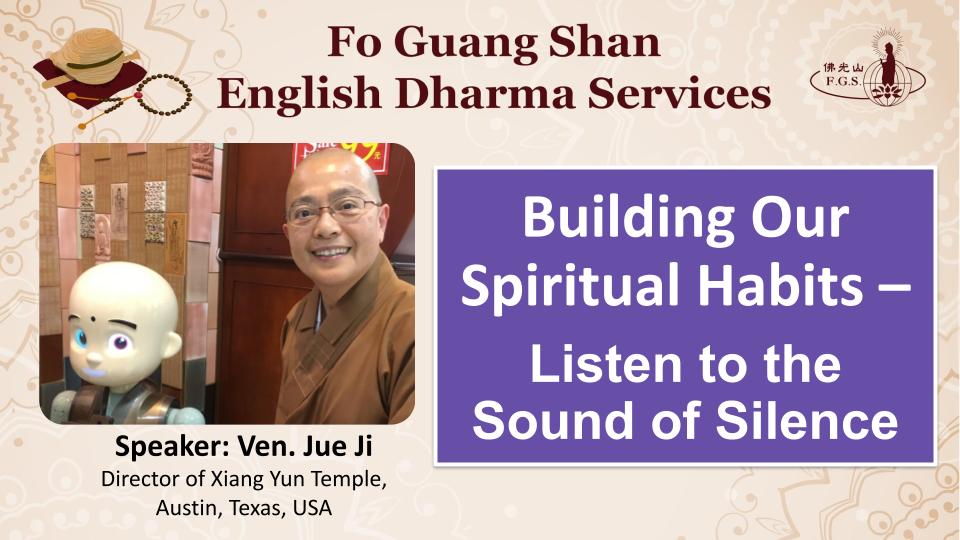
Speaker: Venerable Jue Ji
Director of Xiang Yun Temple, Austin, Texas, U.S.A
I am not going to tell you about the song written by Paul Simon. What I want to talk about is the Sound of Silence from your heart. At first, let me tell you a ko’an story entitled the “Sound of a Single Hand.”
I. Listen to the Sound of Silence
Once upon a time, there was a novice monk, who having seen the elder monks entering the meditation hall for meditation, arose in his heart great admiration. One day, he summed up his courage to ask his master for permission to enter the meditation hall with the elder monks for meditation. The master replied, “It takes lots of efforts to practice meditation, strictly forbidding playing any games and entertainment. You are too young to do that. Wait until you grow older.”
But the novice monk wouldn’t give up. He further requested, “Master, I promise that I’ll stick to the practice. Please give me a chance.”
The master couldn’t help but allowed him and said, “All right. Listen! You can hear the sound of two hands clap. Now you enter the meditation hall. Then, tell me what the sound of a single hand is.”
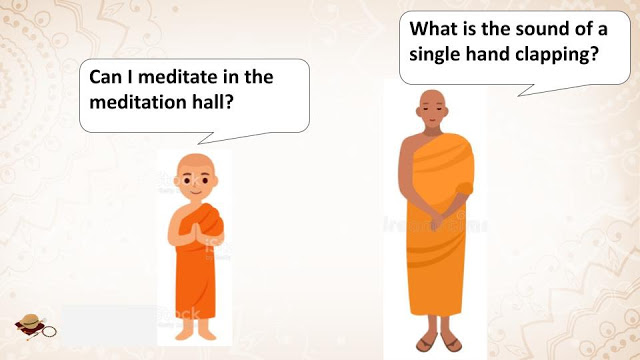
The novice monk excused himself out of his master’s room with a bow. Then he began to contemplate on this question. Through a window, he heard the sound of musical instrument from outside. Immediately and joyfully, he cried out, “I got it!” Then he went to his master and played the sound of the musical instrument that he had heard.
The master said, “No, no. That’s not the sound of a single hand.”
The novice monk thought, perhaps that music was disrupted. Then he moved to a remote and silent place, contemplating on what “the sound of a single hand” was. Suddenly he heard the sound of water drops. He ran to his master straightaway and imitated the sound of water drops.
The master replied, “That’s sound of water drops, not the sound of a single hand. Go meditate again.”
The novice monk could not help but practicing sitting meditation to listen to the sound a single hand. But all his efforts were in vain. What he heard everyday were the sounds of wind, cicada, warm, owl. For three years, he had been reporting to his master for more than ten times, but was turned off all the same. “What on earth is the sound of a single hand?” he meditated. Finally he attained a mental state that went beyond all sounds.

The novice monk thought to himself, “All worldly sounds are impermanent. Only the Sound of Silence can be regarded as the sound of a single hand.”
This is a very famous ko’an story, which offers a question for meditation students to contemplate: Two hands clapping each other would produce sound; what will be the sound of a single hand? How can a meditator hear the sound of one single hand?
II. Between Silence and Sound
It appears nonsense when hearing the question. But it is a very good question for beginners to experience the world of non-discrimination. No sound means a lot of sounds, and vice versa!
When experiencing a world of no sound, it is equivalent to say that we enter a world of lots of sounds! Silence is not different from noisiness. It’s the dualistic mind that separates the silent from the noisy. When we sit silently on the sitting cushion, lots of noises arise from our mind. How strange! And yet how true it is! The meditation room is so quiet, yet our mind is so “noisy”, like a chattering box annoying our resolution in concentrating our mind on even a single moment of here-and-now.
For many Buddhist practitioners, meditation is a very essential Buddhist element that would enhance the spiritual cultivation. Many people try it, but very few could insist on a regular daily meditation practice. Why? There are too many distractions in this modern hi-tech era! We are more or less “kidnapped” by the social media and hardly can we find a solitude moment for meditation. Even having planned a routine schedule for meditation, the all-time bombardment of messages from social media would have drained out our time before we can squeeze even a moment of solitude for a humble meditation practice.

What can we do?
I have a formula for this. I call it meditation on the “sound of silence.” It is simple and easy to apply in our daily life. From the Ko’an story of the “Sound of a Single Hand”, we understand that silence and noise are two sides of a coin. When we talk, at the same time, we listen. Silence and sound can co-exist in a conversation. It’s non-dualistic existence. Here’s the approach: Firstly, we create a silent and positive conversation; secondly, we listen attentively; thirdly, we listen to the sound of silence.
III. Create a silent and positive conversation
It is easy to speak by using our vocal cord, but difficult to do it through our mind. This takes trainings time and time again. For example, when we eat, we silently say to the food, “Thank you for nourishing my body.” At the same time, we listen to what the food replies to us, “Take the energy of me to do good deeds.” It is important that we create silent and positive conversations. That would lead us think positively and behave confidently.
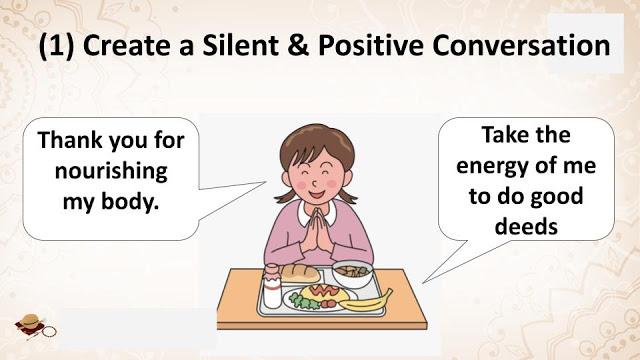
Of course, we know that it is not the food that is responding us. Actually it is our mind talking to us. And it is we who “write” the script of the conversation. The conversation can be we and the flowers in our garden, the bowls and plates on our dining table, the clothes in our closets, the notebook on our desk, the cell phone in our hand, etc. It is not only a silent conversation with the non-sentient beings. Our silent conversation can be with living beings, such as our family, colleagues, friends, pet animals, etc. Talk to them silently but proactively. It is a positive mindset on the making, which is important for meditation students. This would set a solid foundation for concentration of the mind.
IV. Listen attentively
The secret to listen attentively is to listen to “one thing at a time”. In the modern world, we’ve been trained multi-task in work provided by all the hi-tech devices. For example, we can do all the following at the same time: listening to a piece of YouTube music, typing on the desktop keyboard, asking “Siri” to map a nearby supermarket for shopping, planning a trip for tomorrow, etc.
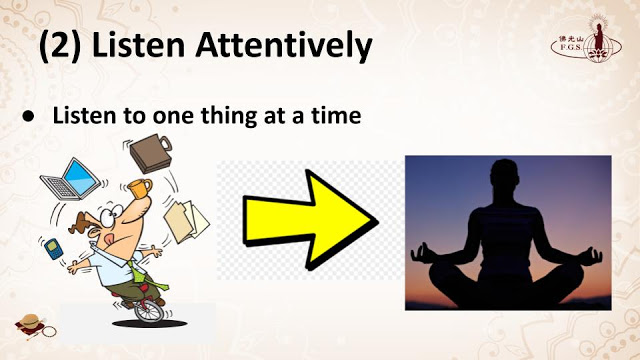
While it is very efficient that we do all these at the same time, it is also very distractive for the mind to concentrate on each of the item that we are doing. The mind becomes used to be distracted anytime, anywhere. It is a habit we obtain through daily juggling duties. This eventually leads us to restlessness when coming to our sitting cushion. Let us concentrate on one thing at a time. Quality time spent is more important than quantity items achieved. Focus on each thing that we are doing, each individual that we are talking to. This is our mindfulness meditation. This would open a “window” for us to see the world and listen to them mind to mind.
V. Listen to the Sound of Silence
Be prepared, the Sound of Silence can be very NOISY! But we are ready for it now.
The novice monk in the Ko’an story that I mentioned earlier, exclaimed after three years of meditating on the “Sound of a Single Hand”, that “All worldly sounds are impermanent. Only the Sound of Silence can be regarded as the sound of a single hand.”
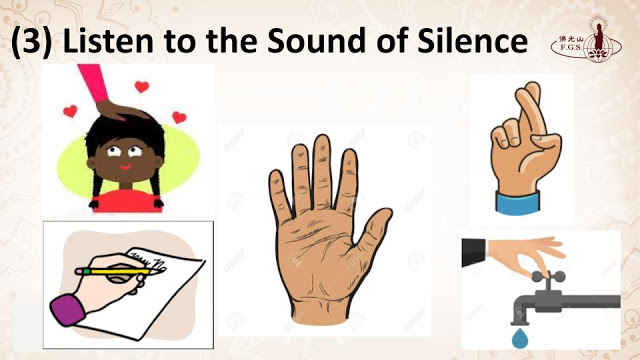
Lift up one of your hands, look at it, and listen to it. Many things can possibly happen after lifting up that single hand in the air. It may pat on the face of a crying baby, turn off the faucet of running water, write a romantic poem to a beauty, and YES, twist the fingers! A lot of possibilities can happen to that single hand and make tons of sounds. Yet, before all these potential actions occur, we hear only the sound of silence. But in fact, even before anything happens, that single hand also has something going on. For example, the air flows through the fingers, the heat emits from the palms, and the sweats perspire and filter out through the pores. Many things happen to the single hand holding up in the air. But we hardly pay any attention to these. The training of listening to the Sound of Silence would enable us to listen with a non-dualistic mind. We listen to the impermanent phenomena with a non-judgmental mind. We listen to everything as it IS. Accepting the world as it is, this helps us to embrace the world and be oneness with the world, the highest state of mind.
VI. Conclusion
There are people we encounter, things we do, words we say in our daily life. In practicing meditation, we need not to limit our meditation spot on the sitting cushion. We should broaden our meditation space to that we experience in our daily life. From the time we wake up in the morning till the time we sleep in the evening, we can take any session of that daily life experience as our meditation session. This is “Living Chan” promoted by Humanistic Buddhism. The taste of Chan is in our daily experiences. When we can listen to the “Sound of Silence”, the taste of Chan is there. Isn’t it wonderful that we can have that taste of Chan in our daily life? So, let’s meditate on the “Sound of Silence.” And LISTEN to the “Sound of Silence.”

